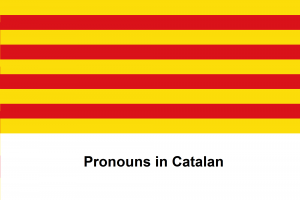Language/Catalan/Grammar/Pronouns
Hi Catalan learners! 😊
In today's lesson, we will be discussing one of the most important elements of Catalan grammar: pronouns. Pronouns are words that take the place of nouns in a sentence. They are an essential part of communication and can help make our language more concise and efficient.
With the completion of this lesson, consider investigating these related pages: How to say "there is" in Catalan, Indefinite Articles in Catalan, Locative Case in Catalan & Comparatives and Superlatives.
Subject Pronouns[edit | edit source]
Subject pronouns are used to indicate the subject of a sentence. In Catalan, subject pronouns are often omitted because the verb conjugation already indicates the subject. However, they can still be used for emphasis or clarity.
Here is a table of the subject pronouns in Catalan:
| Catalan subject pronouns | English equivalent |
|---|---|
| jo | I |
| tu | you (singular) |
| ell/ella | he/she/it |
| nosaltres | we |
| vosaltres | you (plural) |
| ells/elles | they |
Notice that the Catalan subject pronouns have different forms for singular and plural subjects.
Object Pronouns[edit | edit source]
Object pronouns are used to indicate the object of a sentence. In Catalan, object pronouns can come before or after the verb, depending on the sentence structure. Here is a table of the object pronouns in Catalan:
| Catalan object pronouns | English equivalent |
|---|---|
| em | me |
| et | you (singular, informal) |
| el/la | him/her/it |
| ens | us |
| us | you (plural) |
| els/les | them |
Notice that the object pronouns also have different forms for singular and plural objects, and that they have different forms depending on the gender of the object.
Possessive Pronouns[edit | edit source]
Possessive pronouns are used to indicate possession or ownership. In Catalan, possessive pronouns agree with the gender and number of the noun they are referring to. Here is a table of the possessive pronouns in Catalan:
| Catalan possessive pronouns | English equivalent |
|---|---|
| el meu/la meva | my (singular, masculine/feminine) |
| el teu/la teva | your (singular, masculine/feminine) |
| el seu/la seva | his/her/its/your (formal, singular, masculine/feminine) |
| el nostre/la nostra | our (masculine/feminine) |
| el vostre/la vostra | your (masculine/feminine) |
| el seu/la seva | their/your (formal, plural, masculine/feminine) |
Demonstrative Pronouns[edit | edit source]
Demonstrative pronouns are used to indicate which noun is being referred to. In Catalan, the demonstrative pronouns also agree with the gender and number of the noun. Here is a table of the demonstrative pronouns in Catalan:
| Catalan demonstrative pronouns | English equivalent |
|---|---|
| aquest/aquesta | this (masculine/feminine) |
| aquell/aquella | that (masculine/feminine) |
| això | this/that (neuter) |
| aquests/aquestes | these (masculine/feminine) |
| aquells/aquelles | those (masculine/feminine) |
Reflexive Pronouns[edit | edit source]
Reflexive pronouns are used to indicate that the subject and the object of the sentence are the same. In Catalan, reflexive pronouns are formed by adding "se" to the end of the object pronoun. Here is a table of the reflexive pronouns in Catalan:
| Catalan reflexive pronouns | English equivalent |
|---|---|
| em | myself |
| et | yourself (singular, informal) |
| es | himself/herself/itself/yourself (formal, singular) |
| ens | ourselves |
| us | yourselves (plural) |
| es | themselves/yourselves (formal, plural) |
Remember that reflexive pronouns are only used when the subject and object are the same.
Examples[edit | edit source]
| ENGLISH | CATALAN |
|---|---|
| WITH ME | AMB MI |
| WITH YOU | AMB VOSTÈ |
| WITH HIM | AMB ELL |
| WITH HER | AMB ELLA |
| WITH US | AMB NOSALTRES |
| WITH YOU (PLUR) | AMB VOSALTRES |
| WITH THEM | AMB ELLES |
| ENGLISH | CATALAN |
|---|---|
| YOU SEE ME | VOSTÈ EM VEU |
| I SEE YOU | JO ET VEIG |
| I SEE HIM | JO EL VEIG |
| I SEE HER | JO LA VEIG |
| THEY SEE US | ELLS ENS VEIEN |
| THEY SEE YOU (PLUR) | ELLS US VEIEN |
| I SEE THEM | JO ELS VEIG |
Conclusion[edit | edit source]
Pronouns are an important part of Catalan grammar, and mastering them will help you communicate more effectively in both spoken and written Catalan. Remember to pay attention to the gender and number of the noun that the pronoun refers to, and practice using them in your own sentences.
Other Lessons[edit | edit source]
- Indefinite Articles in Catalan
- Questions
- Interrogative Words in Catalan
- Genitive Case in Catalan
- Gender
- Locative Case in Catalan
- Nouns
- Possessive Case in Catalan
- Accusative Case in Catalan
- Conditional Mood

